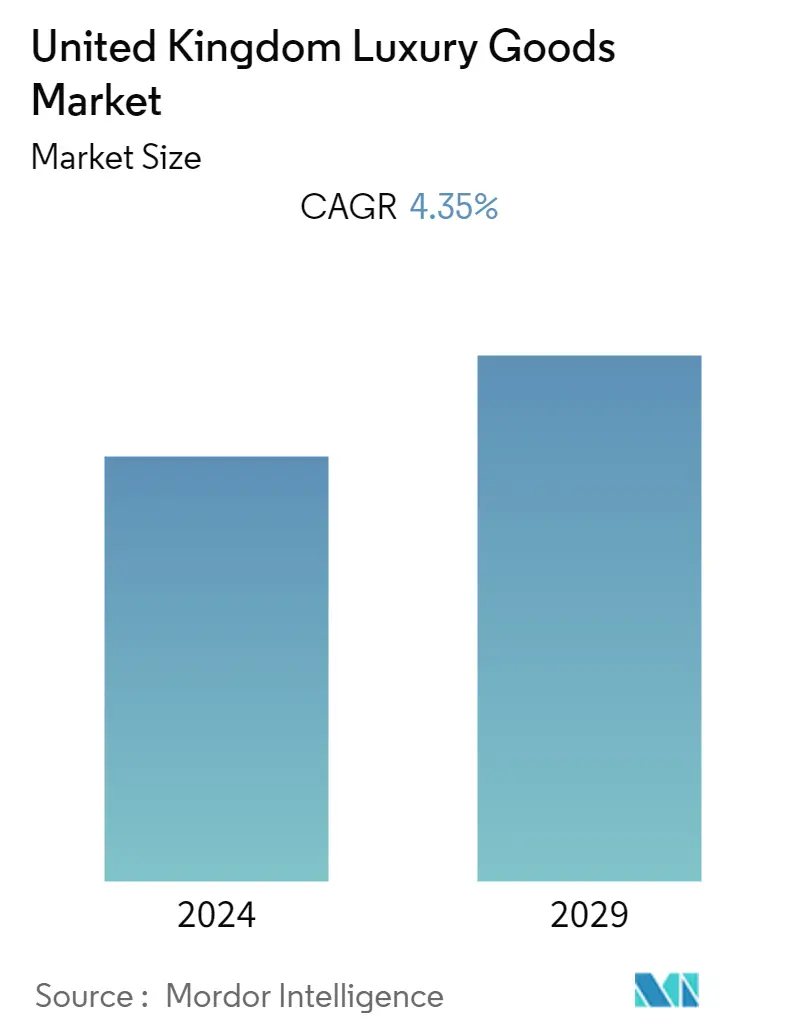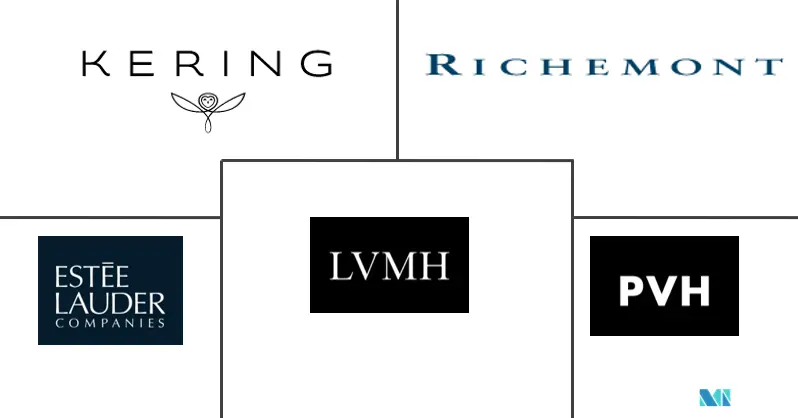Market Size of United Kingdom Luxury Goods Industry

| Study Period | 2019 - 2029 |
| Base Year For Estimation | 2023 |
| Forecast Data Period | 2024 - 2029 |
| Historical Data Period | 2019 - 2022 |
| CAGR | 4.35 % |
| Market Concentration | Low |
Major Players
*Disclaimer: Major Players sorted in no particular order |
UK Luxury Goods Market Analysis
United Kingdom luxury goods market is projected to register a CAGR of 4.35% during the forecast period, 2022-2027.
Rising purchasing power, internet connectivity, and modern and changing lifestyles are in turn influencing positively the spending pattern of the consumers in the market. The luxury consumer in the United Kingdom has a strong impulsive purchasing driver, which is especially prominent among women and older generations. The millennial generation is noticeably more trend-driven and less routine-oriented, which in turn drives the demand for luxury fashion products including apparel, bags, and footwear.
In the long term, the market is expected to register significant growth in leather goods, owing to the well-established leather processing industry, which allows British designers to design high-end bags, apparel, and footwear by utilizing quality leather.
The luxury goods industry is impacted heavily by COVID-19 due to the closure of retail shops and duty-free shops that generate sales mainly at the airport. Covid-19 acted as a catalyst to change the luxury goods market, online shopping for luxury goods soared, and online channels are set to become the leading channel for luxury purchases in the next 3-4 years.
UK Luxury Goods Industry Segmentation
Luxury goods refer to high-priced personal accessories which are often handcrafted with painstaking detail and discipline, featuring extraordinary craftsmanship, and are built with the highest quality materials. United Kingdom's luxury goods market is segmented by type and distribution channels. By type, the market is segmented into clothing and apparel, footwear, bags, jewelry, watches, and other accessories. By distribution channel, the market is divided into single-brand stores, multi-brand stores, online stores, and other distribution channels. The report offers market size and forecasts in value terms (USD million) for all the above segments.
| By Type | |
| Clothing and Apparel | |
| Footwear | |
| Bags | |
| Jewelry | |
| Watches | |
| Other Accessories |
| By Distibution Channel | |
| Single-brand Stores | |
| Multi-brand Stores | |
| Online Stores | |
| Other Distribution Channels |
United Kingdom Luxury Goods Market Size Summary
The UK luxury goods market is experiencing a dynamic transformation, driven by factors such as increased purchasing power, enhanced internet connectivity, and evolving consumer lifestyles. This has led to a shift in spending patterns, with a notable rise in impulsive purchasing, particularly among women and older generations. Millennials, being more trend-driven, are fueling demand for luxury fashion items like apparel, bags, and footwear. The market is poised for substantial growth in leather goods, supported by a robust leather processing industry that enables British designers to create high-end products using quality materials. The COVID-19 pandemic significantly impacted the industry, accelerating the shift towards online shopping, which is expected to dominate luxury purchases in the coming years.
Sustainability is becoming a key focus, with consumers increasingly seeking eco-friendly fashion options. This has prompted major brands to explore sustainable materials, such as vegan leather, to cater to environmentally conscious consumers. The digital economy's rise has further transformed the market, with e-commerce providing new shopping avenues and influencing consumer interactions. Luxury brands are leveraging digital platforms and social media to enhance their reach, with improved logistics and online shopping experiences driving market growth. Prominent players in the market, including LVMH, KERING, and The Estee Lauder Companies, are adopting strategies like new product launches and online expansion to strengthen their market presence.
United Kingdom Luxury Goods Market Size - Table of Contents
-
1. MARKET DYNAMICS
-
1.1 Market Drivers
-
1.2 Market Restraints
-
1.3 Porter's Five Force Analysis
-
1.3.1 Threat of New Entrants
-
1.3.2 Bargaining Power of Buyers/Consumers
-
1.3.3 Bargaining Power of Suppliers
-
1.3.4 Threat of Substitute Products
-
1.3.5 Intensity of Competitive Rivalry
-
-
-
2. MARKET SEGMENTATION
-
2.1 By Type
-
2.1.1 Clothing and Apparel
-
2.1.2 Footwear
-
2.1.3 Bags
-
2.1.4 Jewelry
-
2.1.5 Watches
-
2.1.6 Other Accessories
-
-
2.2 By Distibution Channel
-
2.2.1 Single-brand Stores
-
2.2.2 Multi-brand Stores
-
2.2.3 Online Stores
-
2.2.4 Other Distribution Channels
-
-
United Kingdom Luxury Goods Market Size FAQs
What is the current United Kingdom Luxury Goods Market size?
The United Kingdom Luxury Goods Market is projected to register a CAGR of 4.35% during the forecast period (2024-2029)
Who are the key players in United Kingdom Luxury Goods Market?
The Estee Lauder Companies Inc., KERING, LVMH Moet Hennessy Louis Vuitton, Compagnie Financière Richemont S.A. and PVH Corp. are the major companies operating in the United Kingdom Luxury Goods Market.

